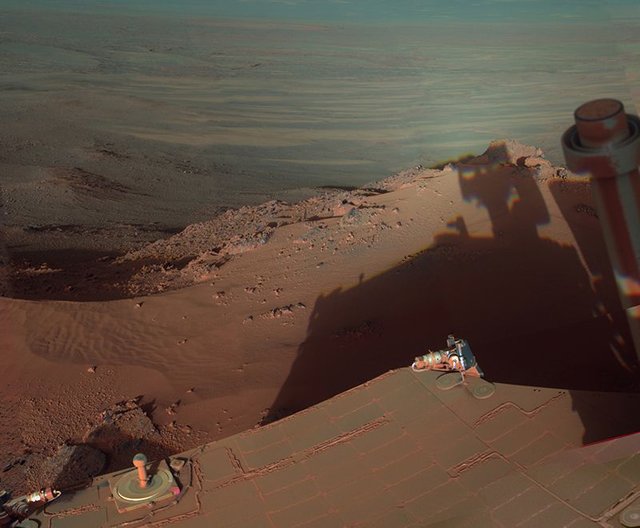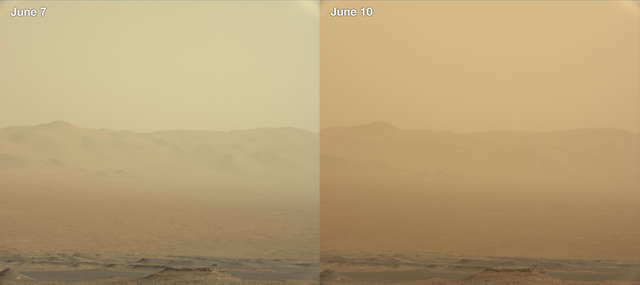Massive Martian dust storm endangers NASA rover
Fifteen-year-old Opportunity rover enters low-power mode in attempt to survive extreme tempest. A postcard from better days: NASA's Opportunity rover looks toward Endeavour Crater on Mars in 2012.Credit: NASA/JPL-Caltech/Cornell/Arizona State Univ.
A postcard from better days: NASA's Opportunity rover looks toward Endeavour Crater on Mars in 2012.Credit: NASA/JPL-Caltech/Cornell/Arizona State Univ.
An enormous dust storm is blanketing much of Mars, blocking the sunlight that NASA’s 15-year-old Opportunity rover needs to survive.
Mission controllers have not heard from the solar-powered Opportunity since 10 June. They believe it is in a low-power mode in which everything except its clock is turned off. “The rover has fallen asleep and is waiting out the storm,” says John Callas, Opportunity programme manager at the Jet Propulsion Laboratory (JPL) in Pasadena, California.
If the rover's power level and temperature don’t drop too low — and predictions suggest they won’t — then Opportunity might be able to wake itself once the dust has cleared. That could take weeks.
“It’s like you have a loved one in a coma in the hospital, and you have the doctors telling you you just have to give it time and she’ll wake up,” says Callas. “But if it’s your 97-year-old grandmother you’re going to be very concerned, and we are. By no means are we out of the woods.”
Extreme event
On 31 May, NASA's Mars Reconnaissance Orbiter spotted the storm about 1,000 kilometres away from Opportunity’s landing site, which is just south of the Martian equator. The storm soon headed towards the rover; within days, Opportunity saw sunlight dimming as atmospheric opacity — a measure of how much dust is in the air — soared. The rover's energy production dropped by half over the course of two days, and then half again in a single day, Callas said during a 13 June media briefing.
In its last transmission, Opportunity reported that the level of atmospheric opacity was twice as high as had ever been measured on Mars. Then the rover went silent.
The dust storm now covers at least a quarter of the planet. It is likely to swaddle nearly all of Mars in the next few days, says Richard Zurek, the chief scientist at JPL's Mars programme office. That would make it the first global dust storm on Mars since 2007 — which Opportunity weathered.
 NASA's Curiosity rover snapped these images of the intensifying Martian dust storm on 7 June (left) and 10 June.Credit: NASA/JPL-Caltech/MSSS
NASA's Curiosity rover snapped these images of the intensifying Martian dust storm on 7 June (left) and 10 June.Credit: NASA/JPL-Caltech/MSSS
One factor working in the rover's favour is that Martian summer will soon begin at its landing site. That means that the days are growing longer and warmer. And the dust storm is also raising temperatures.
Opportunity was designed to withstand temperatures of -55 °C. The coldest temperature predicted for the near future is -36 °C. “We should be able to ride out this storm,” says Callas.
How long the tempest lasts will depend on how far it spreads — and how high it lofts Mars’s talcum powder-like dirt into the atmosphere, says Zurek. A typical dust storm would dissipate in several weeks, whereas the very largest ones might persist for a few months.
NASA’s Curiosity rover, which landed in 2012 about 2,200 kilometres away from Opportunity, is nuclear-powered and not affected by the dust. The storm is expected to abate before the next NASA mission to Mars, the InSight lander, arrives in November. But there is always the chance that a second global storm could arise before then, Zurek says. InSight is expected to be able to survive a landing in dusty conditions.
Planetary puzzle
Why planet-wide dust storms appear in some years and not others is an enduring Martian mystery, Zurek says. On Earth, dust storms crop up in regions such as the American Southwest or the Middle East but stop there. On Mars, such storms can grow quickly to much larger scales — especially when the planet reaches the point in its orbit that is closest to the Sun, and there is more solar radiation to heat dust particles and carry them aloft. Mars is just entering its dust-storm season, which typically occurs during the northern hemisphere autumn and winter, and the southern-hemisphere spring and summer.
It is relatively early in the season for a planet-encircling dust storm to begin, says Huiqun Wang, a research physicist at the Harvard-Smithsonian Center for Astrophysics in Cambridge, Massachusetts. Her team's atmospheric-modelling experiments suggest that a regional Martian dust storm that lasts for at least 10 days could create the atmospheric conditions that would allow it to grow into a global event1. Most never cross that threshold.
Some researchers had predicted that there could be a global dust storm on Mars during the current storm season. Among them is James Shirley, a planetary scientist at JPL who has proposed that Mar's orbital motions can accelerate its atmospheric winds, making a global storm more likely at certain times — including now2. (But Shirley, who has published a series of papers on the idea since 2015, notes he also forecast a global dust storm in the previous Mars year, which did not happen.)
A flotilla of NASA spacecraft at Mars are measuring the ongoing storm in greater detail than ever before. “This is an unprecedented opportunity to learn more about Mars,” says Jim Watzin, head of the Mars exploration programme at NASA’s headquarters in Washington DC.
Martian marathon
Opportunity and its twin, the Spirit rover, launched in 2003 and arrived at Mars in January 2004. Both were designed to last 90 Martian days, or about seven Earth weeks. Spirit landed in Gusev Crater, on the opposite side of the planet from Opportunity, and drove nearly eight kilometres before getting stuck in a sand drift in late 2009. Opportunity landed in a region called Meridiani Planum and, in 2011, reached a 22-kilometre-wide crater named Endeavour. It is currently sitting in Perseverance Valley, on the west rim of Endeavour.
In its more than 5,000 Martian days on the surface, Opportunity has driven 45.16 kilometres — a record for any extraterrestrial vehicle. Its scientific legacy includes the discovery that non-acidic, life-friendly waters existed on Mars roughly 4 billion years ago.